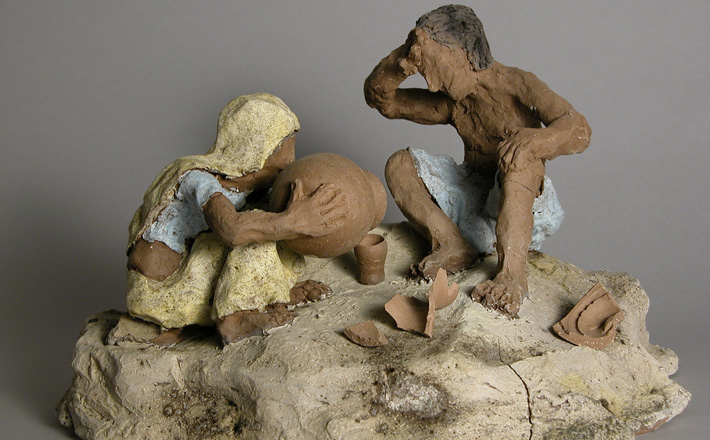Commentary on Romans 5:1-11
I wonder if we are drawn, in part, to Paul’s letters because of their immediacy and transparency.1
We see in them communities that struggled, as we do, with how to live together and live out the gospel. We see people who squabbled over who could and could not eat certain foods; who could and could not speak in church; and whether or not one should get married (not, according to Paul); disagreements that continue to this day. The letters also reveal a man who rejoices in all God has done for him and everyone else — Jew and Gentile. But, at the same time, he writes openly of his failure to live up to God’s expectations, also as we do.
Theology and Christology
Paul is writing to a disparate collection of churches that he had not visited rather than churches he founded. He wrote with the goal that “the God of steadfastness and encouragement [may] grant you to live in harmony with one another, in accordance with Christ Jesus, so that together you may with one voice glorify the God and Father of our Lord Jesus Christ” (Romans 15:5-6). Paul wanted them to recognize, as he did, that there is one God and one Lord.
An important part of our Lenten journey is getting to know this God and the Lord with whom we are making the journey to Jerusalem. The gospel lesson this third Sunday in Lent presents us with the startling exchange between Jesus and a notorious woman in Samaria. At the heart of that lesson is her query, “He [Jesus] cannot be the Messiah, can he?” (John 4:29). Paul seeks to answer her question with a resounding “yes”. Paul wants us to know this man Jesus. Yes, Jesus was and is Messiah, the Christos, the anointed one. Therefore, a homiletical direction one might take is to examine the theological and Christological dimensions of this brief passage.
Paul writes that we have a God who loves us. God loves us so much that, even when we were (and are) weak; even while we were (and are) sinners; even when we were (and are) enemies of God, and each other, God sent God’s son. We have a faithful God who was and is willing to go to any length to reconcile us.
Paul paints a picture of God that is in harmony with the portrait of God given to us by Jesus. This is the God who will search high and low for us when we are lost and have wondered off. Ours is the God who runs out to meet us, the prodigal daughters and sons. And this is a God who forgives us seventy times seventy times seven times. Or, to use a more contemporary phrase, God forgives us a gazillion bazillion times.
Paul also paints a portrait of Jesus, the anointed one. Jesus was sent by God. This Messiah, anointed one, did not demand riches and power. This Christ did not conquer the city on a horse of war. Rather, this Christos rode to his battle on a donkey, a beast of burden. For us he dared to die; to offer his blood so that we would be saved. And through his death we have been reconciled to God. Through his death we are no longer weak, our sins have been forgiven, and we are no longer enemies of God.
A crucial dimension of this passage, therefore, is Paul’s understanding of Christ’s death; his theology of the Atonement. Over and over again Paul reminds us that we are not able to work hard to justify ourselves or bring about our reconciliation with God. That happens only through God’s love and grace. It is a free gift of God. Without the death of Jesus, Paul writes, we all would stand before God guilty and condemned. Only Jesus was able to save us from “the wrath of God” which is our due.
Christ’s Suffering, Our Suffering
This passage also has a strong anthropological dimension. In the midst of discussing Christ’s suffering for us, Paul writes of the Christian life. As he offers us a challenging portrait of what the “peace with God” looks like, is Paul telling us something about his life in Christ?
Paul was a man who thought he had that peace of God; thought he was reconciled to the God of Abraham, Isaac, and Jacob. He had studied and lived the Law, the Torah. He had been an important religious leader. But then he picked up his cross to follow Jesus. He saw that the way of love, forgiveness, and reconciliation can also be a way of suffering.
Paul clearly wrote out of his experiences. In return for being a follower of Jesus he was beaten and imprisoned. And we know that eventually he would ride into Rome, not in triumph, but to his death. It is a chilling experience to stand in Saint John Lateran looking up at the baldacchino over the high altar. At the top are two reliquaries thought to contain the heads of Peter and Paul. For both of these men, to answer the call of Christ was to bring suffering and death.
But in spite of all that he experienced, Paul saw that through his suffering he grew closer to Jesus, closer to God. Employing the rhetorical figure of climax, Paul wants to lead us through suffering, to endurance, to character, and eventually to hope. To follow Jesus will bring us new life and reconciliation to God, but it does not mean that bad things will never happen to us.
For Paul, suffering and endurance are crucial aspects of the faithful life. However, to walk this homiletical path can prove difficult. As preachers it is important to recognize that Paul does not say that God sends this suffering. Likewise, he is not saying that all suffering produces character and must therefore be endured without protest. All too often, in the past, this passage has served to justify pain at the hands of abusers and demand silent acceptance. To quote Paul, “by no means!” No, Paul is encouraging all of us to pick up our cross and follow the way of Christ “because God’s love has been poured into our hour hearts through the Holy Spirit” (Romans 5:5) That is the hope of our lives.
1. Commentary first published on this site on March 27, 2011.


March 19, 2017